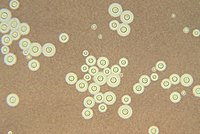
Photo from wikipedia
A 68‐year‐old man presented for outpatient evaluation of dyspnea and new‐onset atrial fibrillation 9 months after undergoing bilateral lung transplantation. Echocardiography prior to cardioversion raised concern for tamponade. Therapeutic pericardiocentesis… Click to show full abstract
A 68‐year‐old man presented for outpatient evaluation of dyspnea and new‐onset atrial fibrillation 9 months after undergoing bilateral lung transplantation. Echocardiography prior to cardioversion raised concern for tamponade. Therapeutic pericardiocentesis returned fluid containing 1875 wbc/mcl (68% pmn) and yielded Cryptococcus neoformans in culture. Cryptococcal antigen was detected in serum at a titer of 1:20. Cerebrospinal (CSF) fluid was without evidence of inflammation and without detectable cryptococcal antigen. There was no radiographic evidence of pulmonary cryptococcosis. Cultures of blood and CSF were without growth. Liposomal amphotericin B (3 mg/kg/day) was administered for 15 days. Oral fluconazole was added on day seven of amphotericin, and the patient was discharged to home 3 days later. Daily dosages of prednisone (10 mg), mycophenolate (500 mg), and tacrolimus (3 mg) at discharge were the same as at hospital admission. He was readmitted 12 days later with dyspnea and with re‐accumulation and loculation of pericardial fluid. A pericardial window was created. Pericardial fluid contained 722 wbc/mcl (35% pmn); Cryptococcus was not identified on direct examinations or cultures of pericardial fluid or tissue. Cryptococcus antigen was present in serum at 1:160. Liposomal amphotericin B was resumed and continued for 2 weeks followed by resumption of fluconazole. Mycophenolate was stopped. Prednisone and tacrolimus were continued. Restrictive pericarditis was evident 3 weeks after window creation. Colchicine was initiated, prednisone increased to 15 mg daily and pericardiectomy planned. We aim to raise awareness to Cryptococcus as a potential etiology for pericarditis in solid organ transplant recipients.
Journal Title: Transplant Infectious Disease
Year Published: 2019
Link to full text (if available)
Share on Social Media: Sign Up to like & get
recommendations!